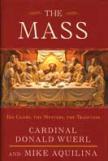Liturgy, a History
The new English translation of the Roman Missal will usher in some of the most dramatic changes to the liturgy since the years following the Second Vatican Council. Clergy and laity will have to master prayers that differ—in some cases dramatically—from those they have been using for more than three decades. The significant changes to the texts of the Gloria and the Sanctus will make it very difficult to use familiar musical arrangements. These changes will render obsolete many introductory works of liturgical catechesis and require the development of new materials.
It is this latter need that The Mass: The Glory, the Mystery, the Tradition seeks to fill. Written by Cardinal Donald Wuerl, archbishop of Washington, and the Catholic author and EWTN television host Mike Aquilina, the book is one of the first popular works on the Eucharist to incorporate and explain the texts of the new translation. Instead of focusing heavily on the new words, however, the authors integrate them into a fresh look at the Mass and its various parts.
The book is divided into two parts. The first, entitled “What Makes the Mass?” discusses the history of the Eucharist and the physical elements used during its celebration: bread, wine, altar, ambo, vestments and so on. The second, entitled “The Mass as It Is,” is a step-by-step journey through the Mass from beginning to end, with explanations of the various actions, words and gestures.
The Mass is both comprehensive and easy to read and might serve as a good resource for adult catechumens and candidates or as the basis for a parish study group on the Eucharist. Although the language rarely rises to the poetic, some of the reflections on the individual parts of the Mass are lovely. The discussion of the Sign of the Cross, for example, notes how this simple gesture is a reflection on Christian faith, “tracing the way God loved the human race, descending from heaven to heart and taking flesh and then ascending to heaven, taking our glorified human nature with Him.”
For readers with deeper knowledge of the liturgy, however, there are aspects of this work that may feel like hitting unmarked speed bumps on an otherwise smooth road. It is not the case, for example, that the three petitions of the Kyrie in the penitential rite are addressed to the three persons of the Trinity. All three petitions are addressed to Christ. Nor is it really true that the changes to the Creed in the new translation were made, as the authors assert, “to reflect the historical creeds with greater accuracy.” The rationale for the changes—indeed, the rationale for all the changes in the new translation—was to bring the English closer to the Roman Missal’s Latin. The Nicene Creed was originally written in Greek and begins—as the new translation of the Creed now does not—with the word “We” rather than “I.”
These errors may seem small, but they are indicative of a casual approach to the details of liturgical history that is pervasive throughout the book. The authors repeatedly use the words “ancient” and “early” to describe parts of the Mass in ways that collapse the distinction between different historical periods and ignore regional differences in liturgical practice that persisted for centuries. In some cases, this leads to anachronisms, as when the authors state that “in ancient times,” Christians with “unforgiven mortal sin” were excluded from the Mass. The phrasing retrojects the more stable understanding of mortal sin and the sacrament of penance that emerged centuries later into a younger church that was still sorting these things out.
The book’s historical difficulties are not confined to ancient history. Given its impact on the way that Catholics worship today, the treatment of the 20th-century liturgical movement is almost absurdly abbreviated. The book’s overview of this history moves in a few sentences from Pius X to Vatican II to Paul VI. There is no mention of the great Benedictine pioneers of the movement, like Lambert Beauduin and Virgil Michel, nor is there even a mention of Pius XII, whose encyclical “Mediator Dei” conferred an important degree of papal approbation on the movement and arguably set the stage for the more far-reaching liturgical reforms of Vatican II.
Is this just scholarly nitpicking? Surely a work of basic catechesis can be forgiven if it tries to simplify a complex history for its readers. The problem is that the various errors, omissions and simplifications, small as they might be individually, all serve to bend the work in a particular direction. The book constructs a narrative according to which the “ancient liturgy” of the “early church” was transmitted essentially intact to Rome, from which it spread, more or less unchanged, throughout Europe and the Americas. The process comes across as so smooth and untroubled that one may wonder why anyone felt the need for liturgical reform in the first place.
One can argue that after 30 years of catechesis that stressed—sometimes overstressed—the discontinuities in our liturgical history, we need more works like The Mass that remind us, in the words of the authors, that “much has changed in Western culture but the Mass is still the Mass.” That theological truth, however, cannot come at the expense of historical truth. This is particularly true if the history being presented seems aimed less at connecting readers with the fullness of the Great Tradition and more at implicitly justifying the recent trend toward micromanagement of liturgical practice by the Roman Curia. The result is not so much catechesis as history written by the victors.
This article also appeared in print, under the headline “Liturgy, a History,” in the May 23, 2011, issue.








